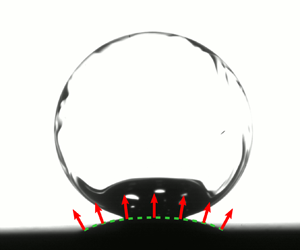Published online by Cambridge University Press: 05 December 2022

The impact of drops on a porous surface with high contact-angle hysteresis and gas discharge is studied. Four different impact modes, ranging from complete repulsion to fast immobilization of a drop on the surface, are identified and mapped in a space spanned by the pressure difference of the gas across the porous surface and the impact Weber number of the drop. The most remarkable aspect of the dynamics is the transformation of a drop into a bubble, which occurs when a drop just overcomes the repulsion by the gas flow and wets the surface. The transition to the regime in which a drop is transformed to a bubble is well described by a simple scaling relationship based on a balance between inertia and the repulsive force due to the gas flow.
Video showing IM0 for a water drop. Drop impact velocity 0.18~m~s$^{-1}$, gas velocity 2.94~m~s$^{-1}$, drop radius 1.42~mm.
Video showing IM1 for a water drop. Drop impact velocity 0.49~m~s$^{-1}$, gas velocity 2.92~m~s$^{-1}$, drop radius 1.37~mm.
Video showing IM2 for a water drop. Drop impact velocity 0.90~m~s$^{-1}$, gas velocity 2.95~m~s$^{-1}$, drop radius 1.41~mm.
Video showing IM3 for a water drop. Drop impact velocity 1.10~m~s$^{-1}$, gas velocity 2.96~m~s$^{-1}$, drop radius 1.42~mm.
Video showing the bubble formation from a water drop. Drop impact velocity 0.67~m~s$^{-1}$, gas velocity 1.64~m~s$^{-1}$, drop radius 1.41~mm.